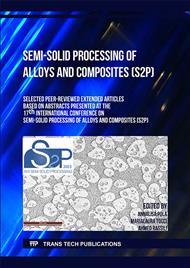p.33
p.39
p.47
p.55
p.61
p.69
p.75
p.83
p.89
Performance and Fundamental Differences between Rheocast and High-Pressure Vacuum Die Cast Al-Si-Mg Alloys
Abstract:
The Al-Si-Mg family is the preferred group of casting alloys due to their excellent castability, good mechanical properties and corrosion resistance. The ENAC-AlSi7Mg0.3 (A356) alloy has been used for decades to produce structural parts such as automotive wheels or suspension parts. However, this alloy cannot be used for high pressure die casting (HPDC) due to die soldering issues. Casting parameters in rheocasting differs greatly from those in HPDC. The lower injection temperature and lower intensification pressure reduce the reactivity between the mould and the aluminium. This lower interaction allows the injection of permanent mould alloys using HPDC. The objective of this work is to compare current structural alloys with rheocasting. A wide range of alloys in the Al-Si-Mg (-Mn) family were cast using the RheometalTM semi-solid technology in addition to ENAC-AlSi7Mg0.3 (A356) used as a comparison basis. Firstly, it was proven that ENAC-AlSi7Mg0.3 (A356) can successfully be cast using rheocast HPDC. Secondly, the impact of magnesium and manganese were studied. Magnesium has a great impact on strength while manganese can further improve the strength by controlling the iron phase morphology. This work proves that various types of alloys can be cast using rheocast HPDC.
Info:
Periodical:
Pages:
75-82
Citation:
Online since:
August 2023
Authors:
Keywords:
Price:
Сopyright:
© 2023 Trans Tech Publications Ltd. All Rights Reserved
Share:
Citation:



